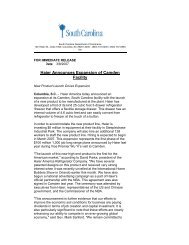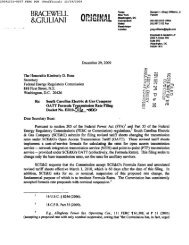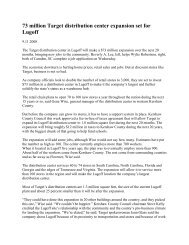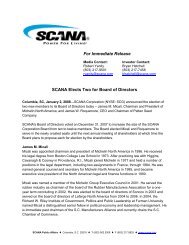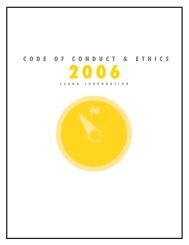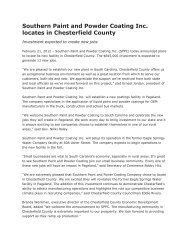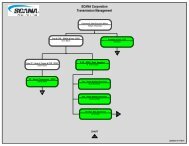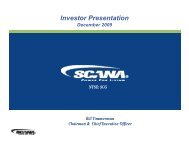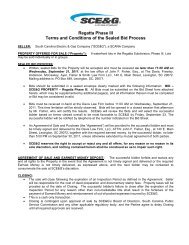10-K - SCANA Corporation
10-K - SCANA Corporation
10-K - SCANA Corporation
You also want an ePaper? Increase the reach of your titles
YUMPU automatically turns print PDFs into web optimized ePapers that Google loves.
Table of Contents<br />
Under SCE&G’s method of funding decommissioning costs, amounts collected through rates are invested in insurance<br />
policies on the lives of certain Company personnel. SCE&G transfers to an external trust fund the amounts collected through electric<br />
rates, insurance proceeds and interest thereon, less expenses. The trusteed asset balance reflects the net cash surrender value of the<br />
insurance policies and cash held by the trust. Management intends for the fund, including earnings thereon, to provide for all eventual<br />
decommissioning expenditures on an after-tax basis.<br />
Accounting for Pensions and Other Postretirement Benefits<br />
<strong>SCANA</strong> recognizes the overfunded or underfunded status of its defined benefit pension plan as an asset or liability in its<br />
balance sheet and changes in funded status as a component of net periodic benefit cost or other comprehensive income, net of tax, or<br />
as a regulatory asset as required by accounting guidance. <strong>SCANA</strong>’s plan is adequately funded under current regulations. Accounting<br />
guidance requires the use of several assumptions, the selection of which may have a large impact on the resulting pension cost or<br />
income recorded. Among the more sensitive assumptions are those surrounding discount rates and expected returns on assets. Net<br />
pension cost of $17.3 million ($13.9 million attributable to SCE&G) recorded in 2011 reflects the use of a 5.56% discount rate,<br />
derived using a cash flow matching technique, and an assumed 8.25% long-term rate of return on plan assets. <strong>SCANA</strong> believes that<br />
these assumptions were, and that the resulting pension income amount was, reasonable. For purposes of comparison, using a discount<br />
rate of 5.31% in 2011 would have increased <strong>SCANA</strong>’s pension cost by $1.3 million. Had the assumed long-term rate of return on<br />
assets been 8.00%, <strong>SCANA</strong>’s pension cost for 2011 would have increased by $1.9 million.<br />
Due to turmoil in the financial markets and the resultant declines in plan asset values in the fourth quarter of 2008, SCE&G<br />
recorded significant amounts of pension cost in 2009, 20<strong>10</strong> and 2011 compared to the pension income recorded previously. However,<br />
in February 2009, SCE&G was granted accounting orders by the SCPSC which allowed it to mitigate a significant portion of this<br />
increased pension cost by deferring as a regulatory asset the amount of pension expense above the level that was included in then<br />
current cost of service rates for its retail electric and gas distribution regulated operations. In July 20<strong>10</strong>, upon the new retail electric<br />
base rates becoming effective, SCE&G began deferring as a regulatory asset all pension cost related to its regulated retail electric<br />
operations that otherwise would have been charged to expense. In November 20<strong>10</strong>, upon the updated gas rates becoming effective<br />
under the RSA, SCE&G began deferring as a regulatory asset, all pension cost related to its regulated natural gas operations that<br />
otherwise would have been charged to expense.<br />
The pension trust is adequately funded under current regulations, and no contributions have been required since 1997.<br />
Management does not anticipate the need to make significant pension contributions until after 2012.<br />
<strong>SCANA</strong> accounts for the cost of its postretirement medical and life insurance benefit plans in a similar manner to that used<br />
for its defined benefit pension plan. This plan is unfunded, so no assumptions related to rate of return on assets impact the net expense<br />
recorded; however, the selection of discount rates can significantly impact the actuarial determination of net expense. <strong>SCANA</strong> used a<br />
discount rate of 5.72%, derived using a cash flow matching technique, and recorded a net cost to SCE&G of $14.0 million for 2011.<br />
Had the selected discount rate been 5.47% (25 basis points lower than the discount rate referenced above), the expense for 2011 would<br />
have been $0.4 million higher. Because the plan provisions include “caps” on company per capita costs, healthcare cost inflation rate<br />
assumptions do not materially impact the net expense recorded.<br />
Asset Retirement Obligations<br />
Consolidated SCE&G accrues for the legal obligation associated with the retirement of long-lived tangible assets that result<br />
from their acquisition, construction, development and normal operation in accordance with applicable accounting guidance. The<br />
obligations are recognized at fair value in the period in which they are incurred and associated asset retirement costs are capitalized as<br />
a part of the carrying amount of the related long-lived assets. Because such obligations relate primarily to Consolidated SCE&G’s<br />
regulated utility operations, their recording has no significant impact on results of operations. As of December 31, 2011, Consolidated<br />
SCE&G has recorded AROs of $124 million for nuclear plant decommissioning (as discussed above) and $326 million for other<br />
conditional obligations related to generation, transmission and distribution properties, including gas pipelines. All of the amounts<br />
recorded in accordance with the relevant accounting guidance are based upon estimates which are subject to varying degrees of<br />
imprecision, particularly since such payments may be made many years in the future. Changes in these estimates will be recorded over<br />
time; however, these changes in estimates are not expected to materially impact results of operations so long as the regulatory<br />
framework for utilities remains in place.<br />
OTHER MATTERS<br />
Nuclear Generation<br />
SCE&G and Santee Cooper are parties to construction and operating agreements in which they agreed to be joint owners, and<br />
share operating costs and generation output, of two 1,117-MW nuclear generation units to be constructed at the<br />
<strong>10</strong>4



